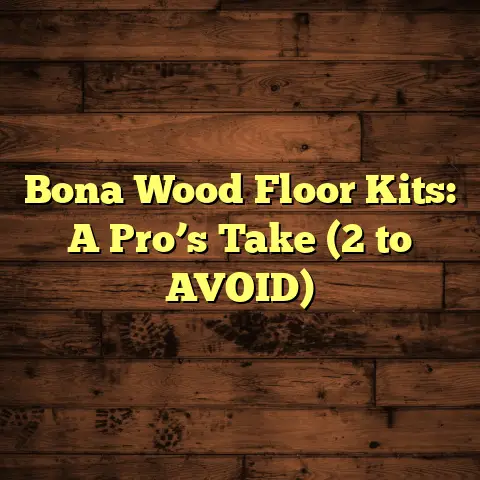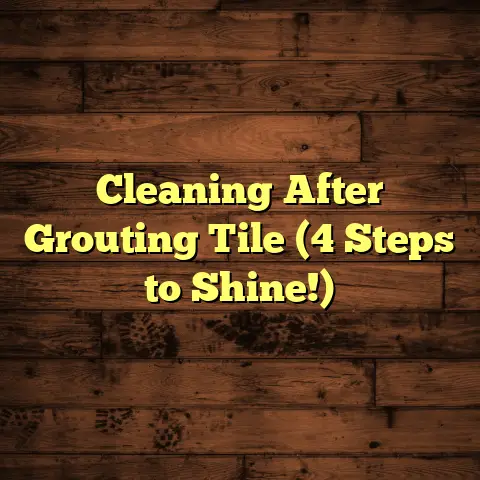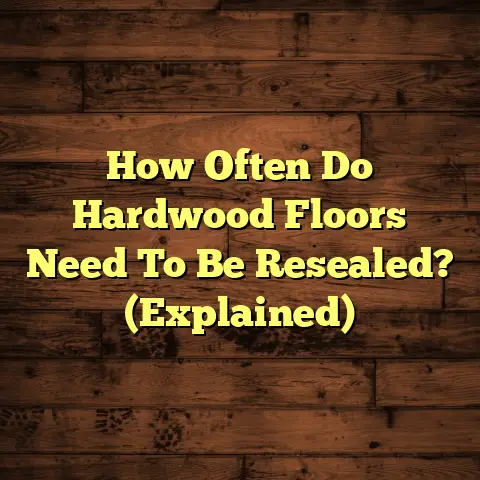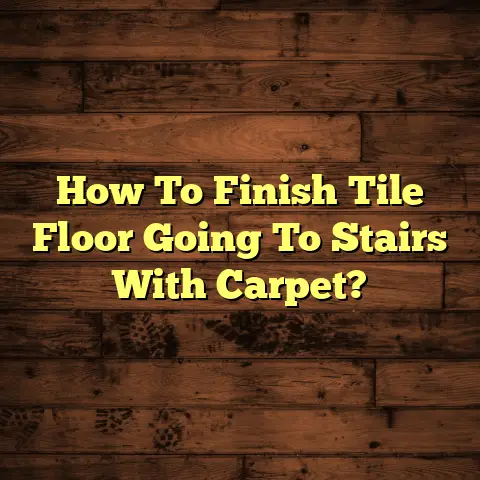Vinyl Flooring Outdoors? (1 Install Mistake!)
Flooring, my friends, is more than just something you walk on.
It’s an art form.
Think about it: the colors, the textures, the patterns…
It all comes together to create a vibe, a feeling, a whole atmosphere.
Just like a painter uses a brush, we use flooring to transform spaces.
We make them functional, but also, beautiful reflections of ourselves.
And when it comes to versatility and durability, vinyl flooring is a star.
You see it everywhere now, even outdoors!
But here’s the thing: even the best vinyl can fail if you mess up the install.
And there’s one mistake in particular that I see all the time.
It can completely ruin your outdoor vinyl flooring dreams.
So, let’s dive in, shall we?
We’ll explore the world of outdoor vinyl and I will show you how to avoid that one critical error.
Section 1: The Rise of Vinyl Flooring
Let’s take a trip down memory lane, shall we?
Vinyl flooring has come a long way.
It started as a humble alternative to traditional materials.
Think wood, stone, and tile.
But now?
It’s a design powerhouse.
It’s affordable, easy to maintain, and the design options are endless.
I remember the days when vinyl was seen as a “cheap” option.
But those days are long gone!
With advancements in technology, we’re seeing vinyl that mimics natural materials.
It looks incredibly realistic.
And people are loving it!
According to a report by Grand View Research, the global vinyl flooring market was valued at USD 37.94 billion in 2022 and is expected to grow. (Source: Grand View Research)
That’s a lot of vinyl!
And a good chunk of that is heading outdoors.
People are realizing that vinyl can be a fantastic option for patios, pool areas, and even outdoor kitchens.
Section 2: Benefits of Using Vinyl Flooring Outdoors
So, why are people choosing vinyl for their outdoor spaces?
Well, let me tell you, the benefits are numerous.
First off, it’s incredibly resistant to moisture.
Unlike wood, it won’t rot or warp when exposed to rain or humidity.
And that’s a huge plus for outdoor applications.
It’s also UV resistant.
That means it won’t fade or discolor when exposed to sunlight.
Think about that harsh summer sun beating down on your deck.
Vinyl can handle it!
And let’s not forget about temperature fluctuations.
Vinyl can withstand extreme heat and cold without cracking or becoming brittle.
I’ve seen it all firsthand.
I’ve worked on projects where homeowners were constantly replacing their wood decks.
They were tired of the maintenance, the splintering, and the constant repairs.
Then they switched to vinyl, and it was a game-changer.
They were able to enjoy their outdoor spaces without all the hassle.
I even had one client tell me that their vinyl deck was cooler to walk on in the summer than their old wood deck.
Now, I can’t guarantee that for everyone, but it’s definitely something to consider!
Section 3: The Ideal Applications for Outdoor Vinyl Flooring
Okay, so where exactly can you use vinyl flooring outdoors?
Well, the possibilities are pretty much endless.
Decks are a popular choice.
Vinyl decking is durable, low-maintenance, and it looks great.
Porches are another great option.
A vinyl porch floor can add a touch of elegance to your entryway.
Balconies can also benefit from vinyl flooring.
It’s lightweight, easy to install, and it can withstand the elements.
And then there are outdoor living spaces.
Think patios, outdoor kitchens, and even poolside areas.
Vinyl flooring can create a seamless transition from your indoor to your outdoor living spaces.
When it comes to design, you have tons of options.
You can choose from a variety of colors, patterns, and textures.
You can even find vinyl that mimics the look of wood, stone, or tile.
One of my favorite styles for outdoor use is wood-look vinyl plank.
It gives you the warmth and beauty of wood without the maintenance.
I also love textured vinyl.
It adds a bit of grip, which is especially important around pools or in areas that get wet.
Section 4: The Importance of Proper Installation
Alright, let’s talk about installation.
This is where things can get tricky.
Proper installation is absolutely crucial for the longevity and performance of your vinyl flooring.
I can’t stress this enough.
Even the best materials will fail if they’re not installed correctly.
Think of it like building a house.
You can have the best lumber, the strongest nails, and the most beautiful windows.
But if the foundation is weak, the whole house will crumble.
It’s the same with vinyl flooring.
A solid foundation and proper installation techniques are essential.
Now, you might be thinking, “I’m pretty handy.
I can probably install vinyl flooring myself.”
And you might be right!
But before you grab your tools, you need to understand the importance of thorough preparation.
And I’ll share the one mistake I see all the time.
Section 5: The One Critical Installation Mistake
Okay, drumroll please…
The single most significant installation mistake when using vinyl flooring outdoors is…
Inadequate Surface Preparation!
I know, it might not sound that exciting, but trust me, this is a big one.
I see it all the time.
Homeowners get so excited about their new vinyl flooring that they rush the preparation process.
They don’t properly clean the surface.
They don’t level it out.
And they don’t ensure that it’s completely dry.
And what happens?
Well, the vinyl starts to lift, warp, or even crack.
Moisture gets trapped underneath, leading to mold and mildew.
It’s a disaster!
I remember one project where a homeowner installed vinyl flooring on their patio without properly leveling the surface.
Within a few months, the vinyl started to buckle and lift.
It looked terrible, and it was a safety hazard.
They had to rip it all out and start over.
And that’s not cheap!
I’ve also seen homeowners use the wrong type of adhesive.
Outdoor vinyl flooring requires a special adhesive that can withstand moisture and temperature fluctuations.
If you use the wrong adhesive, the vinyl will eventually come loose.
It’s like trying to glue two pieces of wood together with Elmer’s glue.
It might work for a little while, but it won’t last.
Section 6: How to Avoid This Mistake
So, how do you avoid this costly mistake?
Well, it all starts with thorough research and preparation.
Take the time to learn about the specific requirements for your vinyl flooring.
Read the manufacturer’s instructions carefully.
And if you’re not comfortable with any of the steps, don’t be afraid to ask for help.
Start by properly cleaning the surface.
Remove any dirt, debris, or old adhesive.
You may need to use a power washer or a chemical cleaner to get the surface completely clean.
Next, level the surface.
Use a self-leveling compound to fill in any cracks or uneven areas.
This will ensure that your vinyl flooring is smooth and stable.
And finally, make sure the surface is completely dry before you start installing the vinyl.
Moisture is the enemy of vinyl flooring.
Use a moisture meter to check the moisture level of the surface.
It should be below the manufacturer’s recommended level.
When it comes to adhesive, always use the type that’s recommended for outdoor vinyl flooring.
And follow the manufacturer’s instructions carefully.
Apply the adhesive evenly and allow it to dry completely before you start walking on the flooring.
I know this all sounds like a lot of work, but trust me, it’s worth it.
Proper surface preparation is the key to a successful and long-lasting vinyl flooring installation.
And if you’re not comfortable doing it yourself, consider hiring a professional.
A qualified flooring contractor can ensure that your vinyl flooring is installed correctly and that it will look beautiful for years to come.
Section 7: Conclusion
So, there you have it.
Vinyl flooring can be a fantastic option for outdoor spaces.
It’s durable, low-maintenance, and it looks great.
But remember, proper installation is absolutely crucial.
Don’t rush the preparation process.
Take the time to clean, level, and dry the surface.
Use the right adhesive.
And if you’re not comfortable doing it yourself, hire a professional.
With a little bit of planning and attention to detail, you can create a beautiful and functional outdoor space that you’ll enjoy for years to come.
Flooring is an art form, and when done right, it can transform your outdoor living experience.
So, go ahead and embrace the potential of vinyl flooring.
Just remember that informed choices lead to lasting beauty and functionality.





